华生及其行为主义心理学理论(Wahson and its theory of behaviorist psychology)
《儿童心理学》华生和行为主义学派
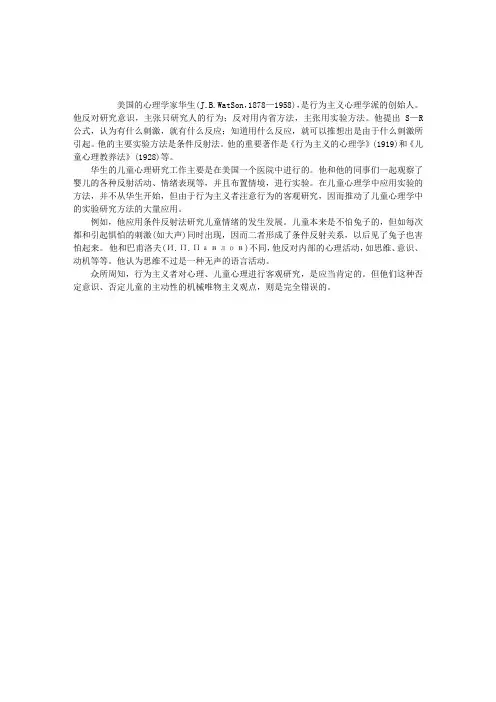
美国的心理学家华生(J.B.WatSon,1878—1958),是行为主义心理学派的创始人。
他反对研究意识,主张只研究人的行为;反对用内省方法,主张用实验方法。
他提出S—R 公式,认为有什么刺激,就有什么反应;知道用什么反应,就可以推想出是由于什么刺激所引起。
他的主要实验方法是条件反射法。
他的重要著作是《行为主义的心理学》(1919)和《儿童心理教养法》(1928)等。
华生的儿童心理研究工作主要是在美国一个医院中进行的。
他和他的同事们一起观察了婴儿的各种反射活动、情绪表现等,并且布置情境,进行实验。
在儿童心理学中应用实验的方法,并不从华生开始,但由于行为主义者注意行为的客观研究,因而推动了儿童心理学中的实验研究方法的大量应用。
例如,他应用条件反射法研究儿童情绪的发生发展。
儿童本来是不怕兔子的,但如每次都和引起惧怕的刺激(如大声)同时出现,因而二者形成了条件反射关系,以后见了兔子也害怕起来。
他和巴甫洛夫(И.П.Павлов)不同,他反对内部的心理活动,如思维、意识、动机等等。
他认为思维不过是一种无声的语言活动。
众所周知,行为主义者对心理、儿童心理进行客观研究,是应当肯定的。
但他们这种否定意识、否定儿童的主动性的机械唯物主义观点,则是完全错误的。
行为主义理论
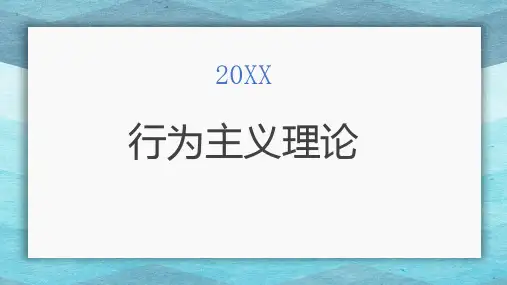
4
Part 2
华生的经典理论
华生的经典理论
1. 条件反射理论
华生把条件反射视为经典行为主义学习理论 的三个规律之一,并把所有复杂的行为都视 为条件反射的结合。他主要关注情感和情绪 的反应,并试图用条件反射来解释这些反应
2
2、行为得到 强化而巩固
3
3、行为通过 观察而获得
2024/7/9
14
···
-
···2024/7/9
谢谢您的 ·观看·
BUSINESS TRIP PROJECT PLAN
汇报人:XXX
汇报时间:XXXXX 15
··· ···
2
行为主义者相信, 行为可以被训练和 改变,而不是由心 理机制驱动的
3
他们认为,行为是 通过条件反射的方 式来学习的,而不 是自发的
4
这种理论的基本思 想是,人们可以通过 外部刺激来改变他 们的行为,而不是 改变他们的内在心 理状态
202主义的理论
行为主义的理论
1
1、行为是 后天形成的
20XX
行为主义理论
-
目录
CONTENTS
2024/7/9
1 华生简介 2 华生的经典理论 3 华生的理论应用 4 行为主义理论的主要观点 5 行为主义理论 6 结论
2
Part 1
华生简介
华生简介 2024/7/9
01
02
约翰·华生(John B. Watson)是美国著名的心理 学家、行为主义心理学的创 始人
华生行为主义
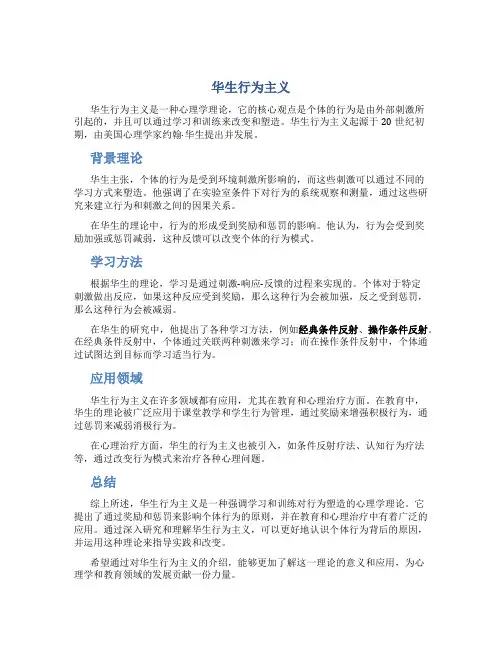
华生行为主义华生行为主义是一种心理学理论,它的核心观点是个体的行为是由外部刺激所引起的,并且可以通过学习和训练来改变和塑造。
华生行为主义起源于20世纪初期,由美国心理学家约翰·华生提出并发展。
背景理论华生主张,个体的行为是受到环境刺激所影响的,而这些刺激可以通过不同的学习方式来塑造。
他强调了在实验室条件下对行为的系统观察和测量,通过这些研究来建立行为和刺激之间的因果关系。
在华生的理论中,行为的形成受到奖励和惩罚的影响。
他认为,行为会受到奖励加强或惩罚减弱,这种反馈可以改变个体的行为模式。
学习方法根据华生的理论,学习是通过刺激-响应-反馈的过程来实现的。
个体对于特定刺激做出反应,如果这种反应受到奖励,那么这种行为会被加强,反之受到惩罚,那么这种行为会被减弱。
在华生的研究中,他提出了各种学习方法,例如经典条件反射、操作条件反射。
在经典条件反射中,个体通过关联两种刺激来学习;而在操作条件反射中,个体通过试图达到目标而学习适当行为。
应用领域华生行为主义在许多领域都有应用,尤其在教育和心理治疗方面。
在教育中,华生的理论被广泛应用于课堂教学和学生行为管理,通过奖励来增强积极行为,通过惩罚来减弱消极行为。
在心理治疗方面,华生的行为主义也被引入,如条件反射疗法、认知行为疗法等,通过改变行为模式来治疗各种心理问题。
总结综上所述,华生行为主义是一种强调学习和训练对行为塑造的心理学理论。
它提出了通过奖励和惩罚来影响个体行为的原则,并在教育和心理治疗中有着广泛的应用。
通过深入研究和理解华生行为主义,可以更好地认识个体行为背后的原因,并运用这种理论来指导实践和改变。
希望通过对华生行为主义的介绍,能够更加了解这一理论的意义和应用,为心理学和教育领域的发展贡献一份力量。
华生的行为主义主要观点
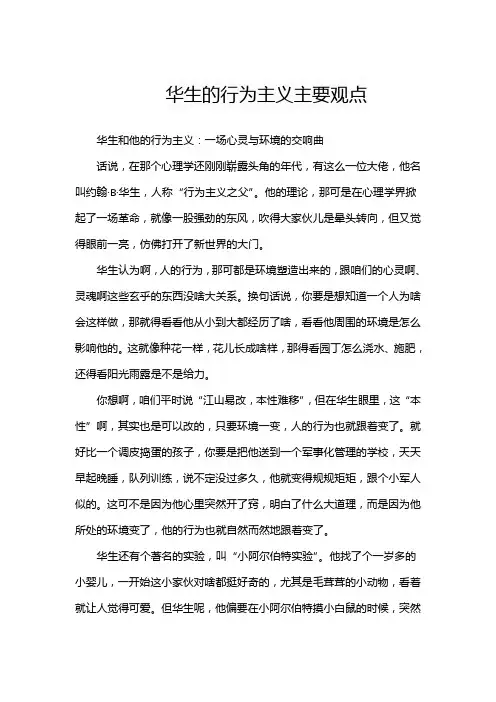
华生的行为主义主要观点华生和他的行为主义:一场心灵与环境的交响曲话说,在那个心理学还刚刚崭露头角的年代,有这么一位大佬,他名叫约翰·B·华生,人称“行为主义之父”。
他的理论,那可是在心理学界掀起了一场革命,就像一股强劲的东风,吹得大家伙儿是晕头转向,但又觉得眼前一亮,仿佛打开了新世界的大门。
华生认为啊,人的行为,那可都是环境塑造出来的,跟咱们的心灵啊、灵魂啊这些玄乎的东西没啥大关系。
换句话说,你要是想知道一个人为啥会这样做,那就得看看他从小到大都经历了啥,看看他周围的环境是怎么影响他的。
这就像种花一样,花儿长成啥样,那得看园丁怎么浇水、施肥,还得看阳光雨露是不是给力。
你想啊,咱们平时说“江山易改,本性难移”,但在华生眼里,这“本性”啊,其实也是可以改的,只要环境一变,人的行为也就跟着变了。
就好比一个调皮捣蛋的孩子,你要是把他送到一个军事化管理的学校,天天早起晚睡,队列训练,说不定没过多久,他就变得规规矩矩,跟个小军人似的。
这可不是因为他心里突然开了窍,明白了什么大道理,而是因为他所处的环境变了,他的行为也就自然而然地跟着变了。
华生还有个著名的实验,叫“小阿尔伯特实验”。
他找了个一岁多的小婴儿,一开始这小家伙对啥都挺好奇的,尤其是毛茸茸的小动物,看着就让人觉得可爱。
但华生呢,他偏要在小阿尔伯特摸小白鼠的时候,突然在身后弄出个大响声,把小家伙吓得哇哇大哭。
就这么反复几次,小阿尔伯特一看到小白鼠,就吓得往妈妈怀里钻,连碰都不敢碰了。
你说这事儿,是不是挺让人唏嘘的?一个孩子,就因为几次不好的经历,就对整个世界产生了恐惧。
这可不就是在告诉我们,人的行为,真的是可以被环境塑造的吗?但话说回来,华生的行为主义也不是一点毛病都没有。
有人就说了,他这理论啊,把人当成了机器,忽略了人的主观能动性和内心的感受。
就好像说,你只要给我一个什么样的环境,我就能给你造出一个什么样的人来,这未免也太机械、太片面了吧?其实啊,这事儿也得辩证地看。
行为主义心理学家华生及其理论
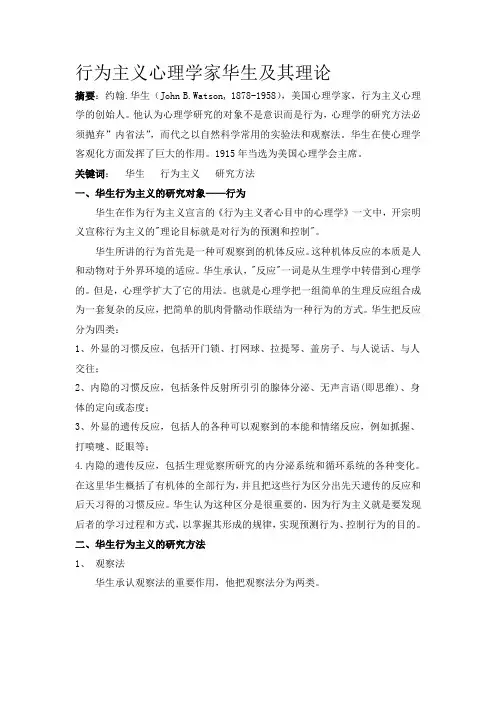
行为主义心理学家华生及其理论摘要:约翰.华生(John B.Watson, 1878-1958),美国心理学家,行为主义心理学的创始人。
他认为心理学研究的对象不是意识而是行为,心理学的研究方法必须抛弃”内省法”,而代之以自然科学常用的实验法和观察法。
华生在使心理学客观化方面发挥了巨大的作用。
1915年当选为美国心理学会主席。
关键词:华生行为主义研究方法一、华生行为主义的研究对象——行为华生在作为行为主义宣言的《行为主义者心目中的心理学》一文中,开宗明义宣称行为主义的"理论目标就是对行为的预测和控制"。
华生所讲的行为首先是一种可观察到的机体反应。
这种机体反应的本质是人和动物对于外界环境的适应。
华生承认,"反应"一词是从生理学中转借到心理学的。
但是,心理学扩大了它的用法。
也就是心理学把一组简单的生理反应组合成为一套复杂的反应,把简单的肌肉骨骼动作联结为一种行为的方式。
华生把反应分为四类:1、外显的习惯反应,包括开门锁、打网球、拉提琴、盖房子、与人说话、与人交往;2、内隐的习惯反应,包括条件反射所引引的腺体分泌、无声言语(即思维)、身体的定向或态度;3、外显的遗传反应,包括人的各种可以观察到的本能和情绪反应,例如抓握、打喷嚏、眨眼等;4.内隐的遗传反应,包括生理觉察所研究的内分泌系统和循环系统的各种变化。
在这里华生概括了有机体的全部行为,并且把这些行为区分出先天遗传的反应和后天习得的习惯反应。
华生认为这种区分是很重要的,因为行为主义就是要发现后者的学习过程和方式,以掌握其形成的规律,实现预测行为、控制行为的目的。
二、华生行为主义的研究方法1、观察法华生承认观察法的重要作用,他把观察法分为两类。
一类是无帮助的观察,也就是通常所讲的自然的观察。
华生认为这种观察也可以了解引起反应的刺激及反应和动作的性质。
但由于对许多现象不能加以充分的控制,因而只能是一种比较粗略简便的方法。
《华生的行为主义》课件

应的联结,需要更全面的理论框架来解释行为。
情感和情绪的重要性
03
情感和情绪在人类行为中扮演着重要角色,华生行为主义忽视
这一点,需要进一步补充和发展。
05
结论
对华生行为主义的理解与总结
华生行为主义强调环境刺激对行为的 影响,认为行为是可预测和控制的, 通过观察和实验来研究行为。
华生主张消除不良习惯和行为,通过 科学的方法进行行为矫正。
行为主义的理论基础
01
02
03
环境决定论
行为主义认为环境刺激是 决定个体行为的主要因素 。
学习理论
行为主义认为学习是通过 经验获得的,并通过强化 和惩罚等手段来塑造行为 。
操作条件作用
行为主义认为可以通过操 作条件作用来改变个体的 行为。
02
华生的行为主义理论
华生的生平简介
约翰·B·华生(John B. Watson),美国心理 学家,行为主义心理学的创始人。
01
1900年毕业于霍普金斯大学,获硕士学 位。
03
02
1878年1月9日出生于美国卡罗来纳州格林 维尔。
04
1903年在美国芝加哥大学获得心理学博士 学位。
1908年成为美国心理学会主席。
05
06
1913年发表了《行为主义者眼中的心理 学》,标志着行为主义心理学的诞生。
华生的行为主义观点
反对研究意识,主张 心理学研究行为。
行为主义强调可观察的行为, 并试图通过实验来研究行为和 环境之间的关系。
行为主义的发展历程
19世纪末期
行为主义开始萌芽,代表人物是 美国的约翰·华生。
20世纪初期
行为主义逐渐发展成为一个心理学 派别,代表人物包括美国的B.F.斯 金纳和加拿大的唐纳德·赫布等。
华生的行为主义理论
华生的行为主义理论约翰·华生(John B.Waston,1878)于1913年首先打出行为主义心理学的旗帜,是美国第一个将巴氏的研究结果作为学习理论基础的人。
他认为学习就是以一种刺激替代另一种刺激建立条件反射的过程。
在华生看来,人类出生时只有几个反射(如打喷嚏、膝跳反射)和情绪反应(如惧、爱、怒等),所有其他行为都是通过条件反射建立新刺激―反应(S-R)联结而形成的。
1913—1930年是早期行为主义时期,由美国心理学家华生在巴甫洛夫条件反射学说的基础上创立的,他主张心理学应该屏弃意识、意象等太多主观的东西,只研究所观察到的并能客观地加以测量的刺激和反应。
毋须理会其中的中间环节,华生称之为“黑箱作业”。
他认为人类的行为都是后天习得的,环境决定了一个人的行为模式,无论是正常的行为还是病态的行为都是经过学习而获得的,也可以通过学习而更改、增加或消除,认为查明了环境刺激与行为反应之间的规律性关系,就能根据刺激预知反应,或根据反应推断刺激,达到预测并控制动物和人的行为的目的。
他认为,行为就是有机体用以适应环境刺激的各种躯体反应的组合,有的表现在外表,有的隐藏在内部,在他眼里人和动物没什么差异,都遵循同样的规律。
行为主义理论的内容行为主义观点认为,心理学不应该研究意识,只应该研究行为。
所谓行为就是有机体用以适应环境变化的各种身体反应的组合。
这些反应不外是肌肉收缩和腺体分泌,它们有的表现在身体外部,有的隐藏在身体内部,强度有大有小。
华生指出一向认为纯属意识的思维和情绪,其实也都是内隐和轻微的身体变化。
前者是全身肌肉,特别是言语器官的变化,后者是内脏和腺体的变化。
20年代以来记录肌肉电位变化的技术不断提高,已经发现心理活动伴有轻微的肌肉收缩。
但连带发生的事件并不一定就是同一事件。
所以思维时有轻微的肌肉收缩,并不足以证明思维就是轻微的肌肉收缩。
华生认为,肌肉收缩和腺体分泌都可归结为物理或化学变化;引起有机体反应的刺激,最后分析也只能是有机体内部和外界的物理或化学变化。
行为主义心理学家华生提出的是一种怎样的心理学理论?
行为主义心理学家华生提出的是一种怎样的心理学理论?
19世纪末,德国心理学家冯特奠定了现代科学心理学的基础,进入20世纪后,美国学心理学家华生则反对冯特学说的形象,创立了一种名为行为主义的全新心理学。
华生认为冯特的心理学过多分析人们的心理活动,这是一种不客观的心理方法。
他反对分析人的意识,更多的研究人的心理,要从行为上来研究。
他提出环境决定论环境对一个人的行为产生了决定性的影响。
他反对单纯的内心活动,所有的内心活动都是通过外部刺激才做出的反应。
可以说华生是首先打出行为主义心理学的旗帜的第一人,是美国第一个将研究结果作为学习理论基础的人。
1930年以后,斯金纳等人也对行为主义作出了发展,他们认为心理学研究的不仅仅是人类行为与外部刺激的关系,还更多的是主动对人施加刺激,这就是彻底的行为主义。
华生是受到巴甫洛夫实验的影响,比如第一步铃声响起后喂狗吃肉,那么狗吃肉的时候会分泌唾液,经过反复多次的刺激,第二步当铃声响起,但不喂狗吃肉,狗依然会分泌唾液,这就是巴甫洛夫提出的经典条件反射。
参考了巴甫洛夫的实验,华生就判断,可以通过刺激和反应来对动物加以控制,这就是他提出的行为主义。
他认为学习就是一种刺激代替另一种刺激,建立条件反射的过程,在华生看来,人类出生只有几个反射(打喷嚏,膝跳反射等)和情绪反应(喜怒哀惧等),所有其他行为都是通过条件反射建立性刺激,然后再反应连接而成的。
华生行为主义学习理论
三、华生的学习理论
(一)、学习的规律 华生认为,学习就是刺激与反应的联结,有机体接受外界 的刺激,然后作出与此对应的反应,也可以说是行为习惯形 成的过程。
频因律:在其他条件相等的情况下,某种行为练习的越多,习惯形 成的就越迅速。因此,练习的次数在习惯形成中起重要作用。
近因律:当反应频繁发生时,最新近的反应比较早的反应更容易得 到强化。
“S-R”
二、华生的行为主义心理学
(二)、研究任务
一是以相当的确定性来预测人的活动; 二是有组织的社会能够凭借我们的各种规律和原则表述来控制人的行 为。
“预测和控制人的行为”
二、华生的行为主义心理学
(三)、研究方法
1.观察法: 2.条件反射法: 不应用和应 最重要的研究 用仪器 方法 4.测验法: 行为测验
3.口头报告法
二、华生的行为主义心理学
(四)、经典实验——人类条件反射研究
华生认为,人有三种原始的或基本的情绪即恐惧、愤怒和爱。
通过这个实验华生认为:
条件化是使情绪复杂化和发展的机制,人的 各种复杂情绪都是在前述三种原始情绪的基 础上,通过条件作用而逐渐形成的。 条件化的情绪反应具有扩散和迁移的作用, 会迁移和泛化到相似的物品上去。 由此可知,情绪反应是人对环境中某种特定 刺激的条件反射。
四、评价
贡献 1、行为主义心理学的产生和发展推进了心理学研究的科学化进程。 2、行为主义心理学推动了学习理论的研究。 3、华生坚决主张心理学研究方法的客观化。
局限 1. 将意识及认知等中介过程排斥在心理学研究的范畴之外。 2. 华生将复杂的行为分解为若干“刺激-反应”单元,从而丢掉了行为的整 体性特征。 3. 企图找出人类和动物的统一行为模式,不考虑行为的整体性、目的性和认 知性特征。
华生行为主义心理学主要观点
华生行为主义心理学主要观点华生行为主义心理学是一种以行为为研究对象的心理学流派,它将心理学的研究范围限定在可观察的行为上,而忽略了内部的心理过程。
华生行为主义心理学的主要观点包括以下几个方面。
一、行为是学习的产物华生行为主义心理学认为,人类的行为是在环境中不断学习和改变的结果。
人们的行为是由外部刺激引起的反应,这些反应又会影响到下一次的行为。
这种学习的过程被称为条件反射。
例如,当狗看到食物时,会分泌唾液。
如果多次在给狗看到食物的同时响铃,最终狗听到响铃就会分泌唾液,这就是条件反射的过程。
二、环境对行为的影响很大华生行为主义心理学认为,环境对人类行为的影响很大。
人们的行为是受到外部刺激的影响,而不是由内部的心理过程控制的。
例如,一个人的恐惧可能是由于遭遇了某种不愉快的经历,而不是由于内部的恐惧感觉引起的。
三、行为可以通过强化和惩罚来改变华生行为主义心理学认为,强化和惩罚是改变行为的有效手段。
强化是指对一种行为给予奖励,以增加该行为的出现频率。
惩罚是指对一种行为给予惩罚,以减少该行为的出现频率。
例如,如果一个儿童在学校表现优秀,老师会给他一些奖励,如表扬、奖章等,以鼓励他继续努力学习。
四、行为可以通过建立联结来学习华生行为主义心理学认为,人们可以通过建立联结来学习。
联结是指两个或更多的刺激之间的联系。
例如,当人们看到火车经过时听到响声,他们就会建立起火车和响声之间的联结。
五、行为可以通过建立模型来学习华生行为主义心理学认为,人们可以通过观察他人的行为来学习。
这种学习方式被称为模仿学习。
例如,一个孩子可能会观察他的父母如何处理冲突,并学习他们的行为方式。
综上所述,华生行为主义心理学主要关注人类行为的学习和改变,认为行为是可观察的,可以通过建立联结、建立模型、强化和惩罚等方式来学习和改变。
这种心理学流派对于人类行为的研究产生了深远的影响,为行为治疗和教育等领域提供了重要的理论基础。
- 1、下载文档前请自行甄别文档内容的完整性,平台不提供额外的编辑、内容补充、找答案等附加服务。
- 2、"仅部分预览"的文档,不可在线预览部分如存在完整性等问题,可反馈申请退款(可完整预览的文档不适用该条件!)。
- 3、如文档侵犯您的权益,请联系客服反馈,我们会尽快为您处理(人工客服工作时间:9:00-18:30)。
华生及其行为主义心理学理论(Wahson and its theory ofbehaviorist psychology)Wahson was a typical example of early behaviorism. He used observation, conditioning, oral reporting, quizzes, and other experimentsMethods, many theories about human feeling, emotion, thought and personality have been obtained, and the law of frequency and the proximate cause of learning have been put forwardLaw learning theory.I. the life and works of WahsonJohn Wason (John, B.Watson, 1878~1958) was born in 1878 in Greenville, South carolina. He grew upEducation begins at school. Wahson admitted that he was not a good student, a little lazy, disobedient, a good fight, and his grades were not goodOK, I can barely upgrade. Just enter the local vollman University was changed.In 1894 he entered vollman University, five years after he got master's degree. Later, he chose University of Chicago as the target of obtaining a doctor of PhilosophyStandard. But his enthusiasm for philosophy soon disappeared in his studies, and he could hardly understand the thoughts ofhis mentor, Dewey. However, in AngelUnder the influence, became interested in psychology, and neuroscience as the second branch. He was under the tutelage of Loeb learning biology and physiology.In 1903 he received a degree in philosophy and got married. He was a lecturer at University of Chicago until 1908. In the past few years, heStudy and work, and do a lot of animal behavior experiments, and show the preference for the behavior of the animals as subjects. Began to form his lineA belief in the direction of a doctrine.In 1908, when Wahson became an assistant professor at the University of Chicago, he was given the post of professor at the University of Hopki. Although WahsonHe was very attached to the University of Chicago, but because of the Hopki University, he was asked to direct the lab, giving him a better salary than the University of ChicagoSome of the best conditions for Wahson eventually came to Hopki university. He spent the most glorious years of his academic career here1920.For a long time, Wahson kept thinking about how to makepsychological research more objective. In 1908, in a handout, he made his first public inquiryThinking about questions. In 1912, at the invitation of the cartel, he made a series of lectures at the Columbia University and talked about the problem in his speech. In 1913 he published his article in psychology review entitled "psychology in the eyes of behaviorist"The birth of the psychology of righteousness marked the beginning of the behaviorist revolution. In 1914 he published his first systematic elaboration of behaviorismMonograph act: an introduction to comparative psychology. The publication of the article and the publication of its monographs have had a major impact on the American Psychological community, especiallyThe response to the vast number of young psychologists. Two years later, when Wahson was 38 years old, he was elected president of the American Psychological association. It also explains from a sideWahson's behaviorism was welcomed by the psychologists. In 1919 he published his second book, psychology, from a behaviorist point of viewStudy. This book is the most comprehensive and systematic exposition of his behaviorist views.In 1920, due to a sensational divorce case was forced Wahson resigned from the Hopki university post, he interrupted a academicExperience. In 1921, Wahson entered the business world. He advertised in a behaviorist way. He found the growth curve of new product sales andThere is striking similarity in the growth of animal or human learning curves". He also spent a lot of time popularizing behaviorism. He writes for many magazinesShao behaviorism, and even lectures in person, to teach behaviorist psychology. In 1925, his book "behaviorism" was published. This book is WahsonThe popular expression of behaviorism. In 1930, Wahson revised the book, his last professional work in psychology.In 1947, Wahson retired from the business world,Spent the last few years of his life on a farm in Connecticut. In 1957, the American Psychological Association taughtIn his part of the award, he praised his work as one of the most important determinants of the form and content of modern psychologyIt is the starting point of a persistent and fruitful research course." Wahson is happy to get such an official recognition. In 1958, Wahson wentHe died at the age of 80.Two, the research object of Wahson's behaviorism behaviorAs Wahson in the declaration of "behaviorism behaviorist psychology" in the eyes of a text, theory of behaviorism "declared at the outsetMarking is the prediction and control of behavior".What Wahson says is, first of all, an observable body reaction. The essence of this body reaction is the adaptation of human beings and animals to the external environment. Wahson acknowledges that the term "response" is borrowed from physiology into psychology. But psychology has expanded its usage. That is, psychologyLearn to combine a simple set of physiological responses into a complex set of reactions that combine simple musculoskeletal movements into a form of behavior. ChinaThe students divide the reactions into four categories:1. apparent habits include opening locks, playing tennis, playing the fiddle, building houses, talking to people, and interacting with people;2. implicit habitual responses include conditioned glands, silent speech (i.e., thinking), body orientation, orattitudes;3., the genetic response to penetrance includes all the observed instinctual and emotional responses, such as gripping, sneezing, blinking, etc.;4. implicit genetic responses, including physiological awareness, various changes in the endocrine system and circulatory system studied.Here, Wahson summarizes all the behavior of organisms, and divides these behavioral areas into innate genetic responses and acquired habitual responses.Wahson believes that this distinction is very important, because behaviorism is to find the latter's learning process and way, in order to master the law of its formationThe purpose of predicting behavior and controlling behavior.Three, the research methods of Wahson behaviorism theoryThe following four research methods are employed:1, observation methodWahson recognized the important role of the observation method. He divided observation into two categories.One kind is the observation without help, that is, what is usually called natural observation. Wahson believes that thisobservation can also be used to understand the stimuli that cause reactionsAnd the nature of the reaction and action. However, due to the fact that many phenomena can not be adequately controlled, it can only be a relatively simple and convenient method.The other is the observation by means of instruments. Wahson believes that all scientific advances are related to improvements in experimental means and equipment. Therefore, psychologyIn order to study behavior and imitate natural science, it is necessary to design precise instruments to control subjects effectively and to study behavior more precisely. suchObservation is, in fact, the usual experimental method.2, conditioned reflexWahson thinks conditioned reflex is a very objective method. He divides conditioned reflex into two categories. One is to obtain conditioned secretory reflexesA method is used to obtain conditioned motion reflex. Not only does Wahson formally incorporate the conditioning method into psychological research, butMoreover, this method is applied to the systematic study of children's emotion.3 oral report methodWahson believes that in the normal people, there is a kind of animal does not exist, and even in the metamorphosis of people who are not perfect ability, that isThe ability to observe changes within the body and to make oral presentations of these changes. Moreover, people are more responsive to situationsOften using language rather than other sports. Sometimes, this is even the only observable response. This also determines the study of people not onlyIt is possible and necessary to adopt oral reporting. Wahson's oral reporting law reports only changes within its own body, notIt is the activity of mind and consciousness, and therefore not the usual introspection.4, test methodWahson believes that with the development of science, the difference between pure academic research and applied research is becoming smaller and smaller, and the test method is gradually appliedThe method becomes the method of research. He believes that one of the major problems with the existing test methods is that most of them are related to language behaviorThis makes it impossible for people with language disabilities to use this method. Therefore, he argued that the design and use of language do not necessarily require explicit external languageBehavioral test of performance.Four, the basic view of Wahson theoryThe basic points of view are as follows:1. about feelingFrom his behaviorist point of view, tried to avoid the use of traditional psychological nouns such as "feeling" and substituting "thorn" in his writings"Shock" and "reaction" and so on. He changed the various sensations to "visual response", "auditory response", "pain response", and also "visual reaction error"Substitution illusion. At the same time, Wahson says it can write a psychology without the terms "consciousness", "mental state" and "heart",It uses the terms "stimulus and response" and "habit formation".2. about the relationship between heredity and environmentIn the early days, Wahson did not deny the existence of instinct, but regarded instinct as a kind of system which was systematically displayed by many stimuliA combination of congenital reactions.Later, however, he advocated the abolition of the concept of instinct in psychology, and argued that the concept of instinct was no longer necessary in psychology. He said, "please."Give me a dozen healthy, no defect babies, and let me nurture in my special world, then I can assure you of the dozen babiesIn the middle of the world, I take one out and train him to be any kind of expert - whether his abilities, hobbies, trends, talents, professions, and...What race is like, I can train him to be a doctor, or a lawyer, or an artist, or a business leader, or...You can train him to be a beggar or a thief." This passage has been widely accepted as the classical expression of environmental determinism.3. about the concept of action flowWahson also proposed the concept of action stream to replace James's stream of consciousness. He made a diagram of all the actions of man's life from simple to complexIt is believed that the action of a person's life is a streamof action, beginning with the fertilized egg, and becoming more complicated with age. Some non learning actionsIt disappears in a very short time, while others retain longer. Wahson called the action flow chart an expression of his behaviorist viewBehaviorism is the act of understanding human behavior through these movements. Action flow provides the realistic background for behaviorism to observe human psychology.4. theories of emotionWahson believes that emotion is a genetic type of reaction that involves profound changes in the whole body mechanism, especially the depth of the visceral and glandular systemsChange of engraving. But he thinks instinct is different from emotion. If the stimulus arises, the adaptation is internal and confined to the body of the subjectSo, this is emotion; if stimulation causes the whole organism to adapt to all kinds of objects, then this is instinct.Wahson believes that people have three primitive or basic emotions, namely fear, anger, and love. The fact that Wahson used conditioned fear responses,It is believed that conditioning is the mechanism that complicates and develops emotions, and all kinds of complex emotions are passed on the basis of the above three kinds ofprimitive emotionsFormed by conditioning.For a detailed understanding of conditioned fear responses, click on the "Albert Albert (Little) experiment" - conditioned emotional response test5. about the theory of thinkingWahson thinks that thinking is also a feeling, movement, behavior. He said that there are two kinds of language habits, one is explicit language habits, and this is the wordLanguage;One is implicit language habits, and this is thinking. Two habits are equivalent in nature, so words are loud thinking,Thought is a silent conversation. Here, he also put forward an important idea, that implicit language habits are explicit language habitsEvolved. At first, the children talked to themselves alone, and later, in the request of adults and society, they became quietWords eventually turn into only the lips. Wahson noticed the connection between speech and thought.Wahson also explains the creative role of thinking. "For all the creative creations of the mind," he said, "we get them,"he saidAs a result of the reaction of playing with words. People change the reactions of words, and finally get a new reaction model, which is different kinds of thinkingProduct.Wahson believes that in addition to the language of human thinking, there are non linguistic forms of thinking. He said that the deaf mute was speakingInstead of vocabulary, their speech and thought are carried out by the same physical responses. Even normal people do not always use itVocabulary for thought. When a person is thinking, he not only has latent language activity, but also has latent limbsPhysical activity and latent visceral activity. And when the latter two activities take advantage, there is no language formed thinking.6. about the theory of personalityWahson believes that personality refers to the existing and potential total assets (Assets) and existing and potential liabilities in response(Liabilities). Wahson refers to the assets:First, the various habits that have been made up, socialized, socialized, adjusted, instinctive, socialized, and temperedVarious emotions, and the various combinations and relationships among these things;Second, plasticity (the ability to form new habits and change old habits) and retention (the speed at which established habits restore their function) is highDegree coefficient. That is, the individual's ability to adapt to the current or future external environment.Debt is the potential factor that does not function in the current environment and prevents it from adapting to the changed environment.Furthermore, Wahson points out that personality is the sum total of all actions, and is the final product of all kinds of customary systems. Personality can change. Because it's ringThe influence of the environment, so the way to change your personality is to change the environment in which people live.Five, Wahson's learning theory - the law of learning1, frequency dependent (frequency) lawWahson believes that, in the case of other conditions equal, the more practice a certain behavior, the habit formation faster. Therefore, the number of exercisesPlay an important role in the formation of habit. In the process of forming habits, the effective actions are maintained and the invalid actions disappearBecause effective actions occur more often than any of these invalid actions, it is because each practice always ends up with effective actionThe.For example, in a very simple "T" type test situation, an organism can only make two possible responses: correct responseR+ to represent) and an error response (expressed in R-). For the sake of simplicity, we assume that the initial strength of R+ and R- is similar. Pass through a systemAfter column attempts, what happens is that R- gradually decreases, while R+ increases gradually. Wahson believes that the reason for such a result is becauseR- only happens in half of the attempt, and R+ happens in every attempt. R+ is stronger than R- because R+ occurs more frequently than R-Double. Wahson uses the number of reactions as the basis for the retention or elimination of reactions.2, the law of proximate cause (recency)Wahson believes that when the reaction occurs frequently, the most recent response, the earlier response, is more likely to be enhanced because there is one in every practiceEffective response is always the last reaction, so this reaction must be more likely to occur in the next exercise. As a result, he left the reaction successfulFar and near as the principle of explaining some reactions to be retained and some reactions being eliminated. In his view, the habit of reaction must be the most successful timeRecent reactions.Six, comments(I) progressive significance of behaviorist psychology;1. the birth and development of behaviorist psychology promote the scientific progress of psychology. Prior to behaviorist psychology, despite experimentsThe method has been applied to the study of psychological problems. However, the requirements and implementation of the comprehensive, objective and natural science of psychology are stillStarting from behaviorist psychology. Wahson argued for an objective approach to studying the observable behavior of humans and animals. This emphasizes in generalThe objectivity of the research object and the objectivity of the research methods. This view is, for psychology, extreme, but it is trueThe bottom clearance of traditional consciousness and psychology of subjectivity, tedious, mystery and conventionality, still play a positive role. That's okFor psychology, the study of psychology has stepped into the category of natural science. Therefore, some scholars call it "the behaviorist revolution", soThe evaluation is not excessive.2. behavioral psychology promotes the study of learning theory. Because Wahson advocates behaviorist psychology to predict, control, and shape organic matterThe behavior of the body, and the change and shaping of behavior, are achieved through the process of learning. Therefore, behaviorist psychology attaches great importance to the learning processResearch 。
